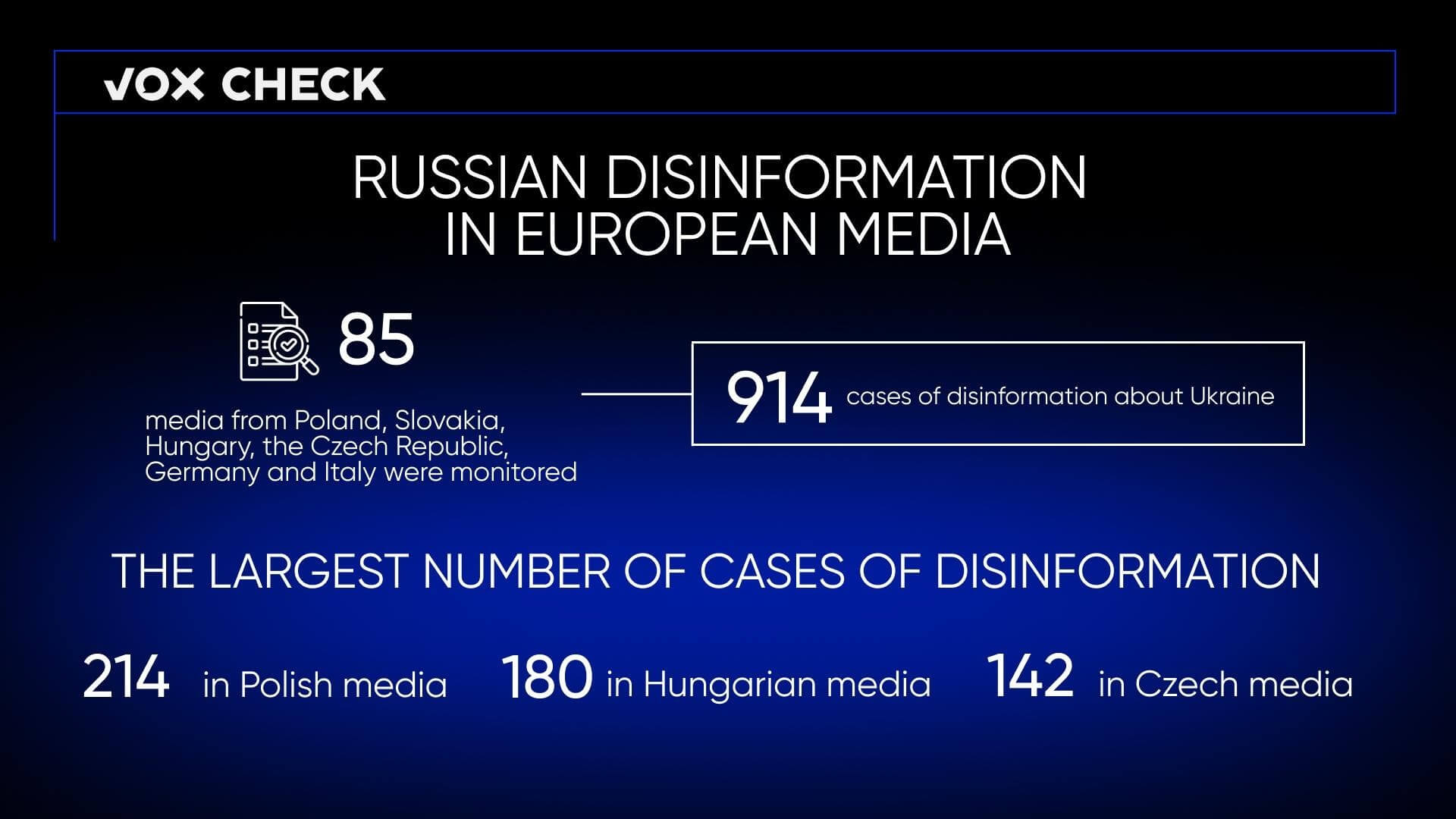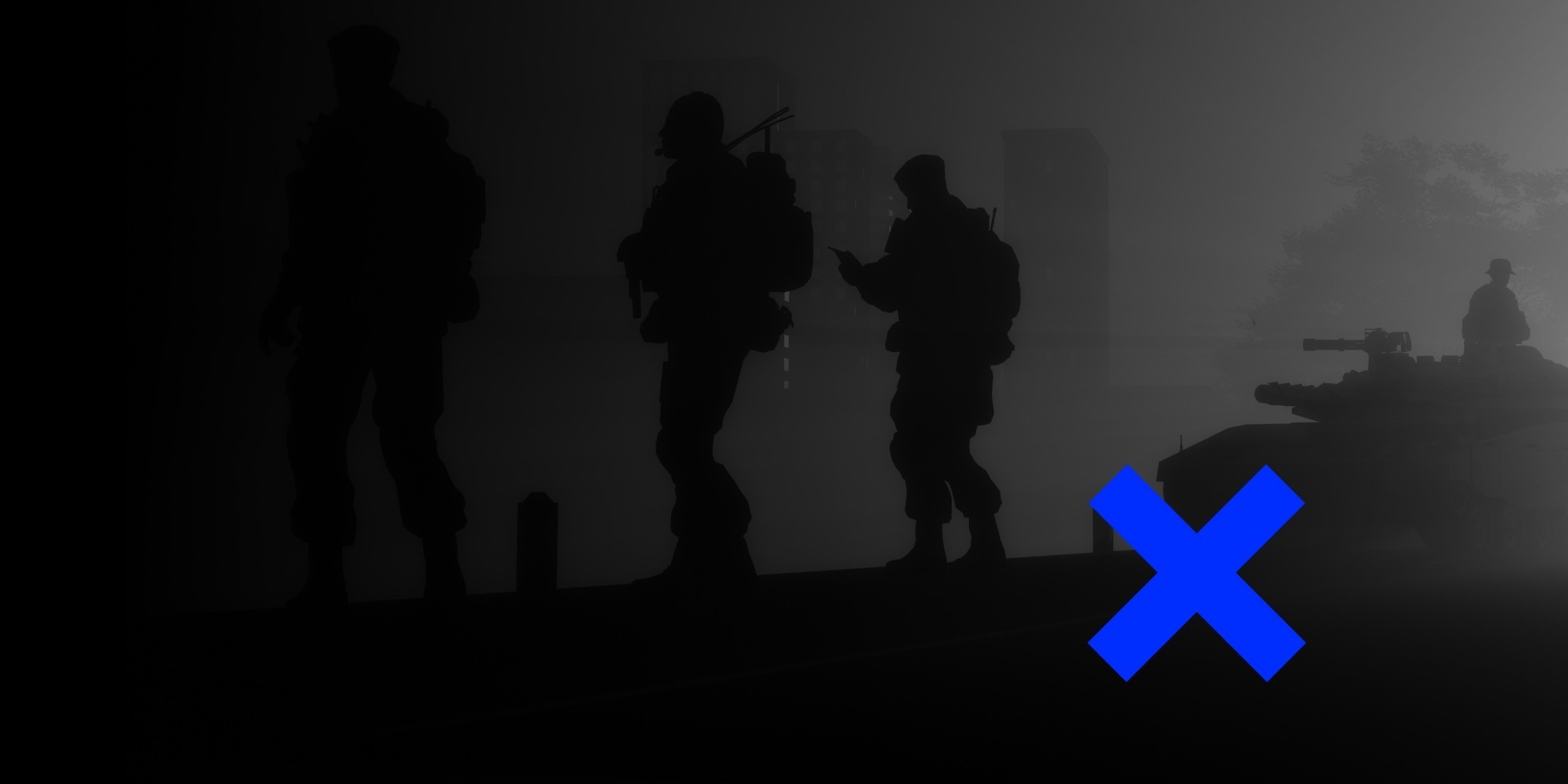In January 2023, VoxCheck monitored 85 media outlets from Poland, Slovakia, Hungary, the Czech Republic, Italy, and Germany and found 914 cases of disinformation about Ukraine. We found the most cases of disinformation in Polish (214), Hungarian (180), and Czech (142) media. In January, the Kremlin’s narratives about the justification of Russian aggression, the Western control over Ukraine, and the discrediting of representatives of the Ukrainian government were most actively promoted in the European media.
VoxCheck monitors the media in European countries (Germany, Italy, the Czech Republic, Slovakia, Poland, and Hungary) and analyzes the disinformation narratives about Ukraine spread by these media. For the most part, the detected fakes and manipulations are consistent with the main narratives of russian disinformation campaigns. Every month, the VoxCheck team publishes a report on the monitoring results. All disinformation messages, grouped into narratives and their refutations, will be displayed on the “Propaganda diary” database website.
Poland
During the monitoring of 10 Polish mass media, we discovered 214 cases of disinformation, which were grouped into 25 narratives. Most cases were related to narratives about Western control over Ukraine (39 cases), the justification of Russian aggression (37 cases), Nazism in Ukraine (27 cases), and narratives about Ukrainian refugees (17 cases).
When talking about Western control over Ukraine, the European media claimed that Europe and the USA do not want peace, which is allegedly evidenced by their actions in Ukraine. On the contrary, according to the media, these countries are the only beneficiaries of the continuation of the conflict. In one of the articles, it was directly written that after the collapse of the USSR, the main goal of the Americans was the disintegration of the Russian Federation, and Ukraine became only a convenient tool for the implementation of such a plan. At the same time, not all materials with this narrative have the same content. If, in some publications, Western countries are considered as a single whole, then, in others, it is said that Ukraine is a “torpedo” that the USA uses to destroy the “Nord Stream” and worsen relations between Germany and Russia. Thus, within this narrative, they are trying to spread the idea of contradictions within the West itself.
In the Polish media, Russian aggression was justified by the need for a “preventive strike“: allegedly, Russian diplomacy was focused on preventing conflicts, but Ukraine and Western countries provoked the Russian Federation and forced it to act decisively. The media indicate that if Russia had not started an invasion, it would itself have become a victim of the aggression of neighboring countries. They also add that Russia’s actions fully comply with the norms of international law, and there is no evidence of Russia’s intentions to change Ukraine’s borders. In addition, as part of this narrative, justifications for Russian missile strikes are occasionally disseminated. For example, fakes that strikes on Ukraine’s energy infrastructure are a response to the “terrorist attack” on the Crimean Bridge.
European media tried to prove the existence of Nazi ideology in Ukraine with the help of a familiar set of propaganda stamps: “Russophobic policy of Ukraine”, “power has been held captive by the Nazis since 2014”, and “Nazi marches are held in Ukraine”. They added the thesis that the Poles should support Russia, because the dismantling of “Ukrainian Nazism” is also beneficial for Poland’s security.
Ukrainian refugees are depicted in disinformation reports as a completely destructive force: according to the Polish media, they receive privileges in Poland, while the needs of ordinary Poles are often ignored. What’s more, together with the flow of Ukrainian refugees, the level of corruption, political chaos, and inter-ethnic conflicts in Poland will likely increase. The structure of the economy will also change, which will lead to instability.
Slovakia
As a result of monitoring 13 media in Slovakia, we found 129 cases of disinformation, which can be grouped into 16 narratives. Narratives about the justification of Russian aggression (23 cases), the Western total control over Ukraine (21 cases), the inevitable loss of Ukraine in the war (16 cases) and the discrediting of representatives of the Ukrainian government (13 cases) turned out to be the most widespread.
The Slovak pro-Russian media once again repeated the rationale for the war, which can be heard every day on Russian state channels: the use of the Minsk agreements to “prepare aggression against Russia”, the “illegal approach” of NATO to the Russian borders, the “pro-American coup” in Kyiv in 2014. The media continue to spread fakes, as if representatives of the West (ex-chancellor of Germany Merkel and ex-president of France Hollande) today openly admit that no one was going to adhere to peace agreements with Russia.
As part of the narrative about the Western control over Ukraine, the authors of the fakes mainly accused the “Anglo-Saxons” (the USA and Great Britain) of inciting the war and continuing to provide armed support to Ukraine. According to them, Ukraine is still suffering, losing civilians and soldiers only for the sake of the interests of the West, namely the political elites and the military-industrial complex. It is worth depriving Ukraine of Western support — and it is supposed to instantly capitulate to Russia. Thus, in this narrative, the media deny any subjectivity of Ukraine.
In January, pro-Russian speakers continued to predict the inevitable defeat of Ukraine in the war with the Russian Federation. In particular, the loss of Ukraine was discussed in the context of mobilization in Russia, its preparation for a new offensive, and heavy fighting in Donbas. “Do not believe the constant propaganda of the US government and the media about Ukraine. Ukraine will not win the war, but, on the contrary, will suffer huge losses,” — this is how the publications tried to “disprove” the idea that Ukraine still has a chance for a military victory. Weak Western support, large human losses of the Armed Forces of Ukraine, and significant resources of Russia, the articles say, may lead to the collapse of the Ukrainian army and a change of the political regime in Kyiv already in the spring and summer of 2023.
President of Ukraine Volodymyr Zelenskyi became the main object of discredit among Ukrainian politicians in the European media. Trying to reduce the seriousness of his perception, fake authors used already traditional fakes about the president’s drug addiction and the role of a comedian in public office. Among the new fakes is a comparison of the Ukrainian president with Mikheil Saakashvili. Allegedly, the fate of the ex-president of Georgia awaits Zelenskyi — the loss of power and persecution within the country. The mass media also spread other throw-ins to the existence of a conflict within the military-political leadership of Ukraine. Yes, they claim that Zelenskyi is jealous of the popularity of the Commander-in-Chief of the Armed Forces of Ukraine, Zaluzhnyi, and is going to eliminate him. And Denys Monastistyrskyi, the Minister of Internal Affairs, who died in a helicopter crash, allegedly already became a victim of the Presidential Office as he sought to gain more influence and more independence in the power structure.
Hungary
We monitored 13 Hungarian publications, found 180 cases of disinformation and distributed them among 20 narratives. The most common were narratives about the justification of Russian aggression (49 cases), Western control over Ukraine (30 cases), and the fact that Ukrainians allegedly want to join Russia (14 cases).
In January, the narrative intended to justify aggression against Ukraine remained relevant in the Hungarian media. The messages themselves were similar to Russian disinformation campaigns: for example, the protection of the population of Donbas, the expansion of NATO in Eastern Europe, Ukraine’s refusal of neutrality and non-alignment, the “Nazi ideology of the Kyiv regime” as the reasons that forced Russia to launch a preemptive strike on Ukraine. In particular, Russian politicians, such as President Putin or the Secretary of the Security Council of the Russian Federation, Patrushev, were repeatedly quoted in the Hungarian mass media, and the authors of the publications never questioned the words of representatives of the Russian Federation. Western pro-Russian speakers are also sometimes quoted, such as the American Scott Ritter, who regularly appears on Russian channels. With the help of foreign “experts”, propaganda tries to legitimize the position of the aggressor.
During the same period, the media also actively promoted the narrative that Ukraine is under the complete control of the West. Yes, there were statements that it was precisely because of Western pressure that Ukraine refused to negotiate with Russia. One of the examples cited in the publications is the talks in Istanbul at the end of March 2022, which did not end in peace agreements. According to the propagandists, Ukraine was then forced to continue hostilities in order to finally exhaust Russia. Moreover, the partners’ policy is not to help Ukraine but to “sacrifice it” for the sake of weakening the Russian state.
Another common narrative about Ukrainians wanting to join Russia was the repetition of fakes about “honest expression of will” in Russian pseudo-referendums in Crimea in 2014 and in Zaporizhzhia, Kherson, Donetsk, and Luhansk regions in 2022. The illegality of the “votes” and numerous falsifications on them were ignored in such reports.
Also relatively widespread (12 cases) was the narrative that providing aid to Ukraine is prolonging the war. As part of it, the propagandists said that Western weapons only continue the bloodshed, lead to the escalation of the conflict, and do not contribute to the preparation for the negotiation process. In this situation, they are trying to portray Russia as a constructive party that is ready to go to a peaceful settlement.
Czechia
As part of the monitoring of 13 Czech media in January, we discovered 142 cases of Russian disinformation and 14 narratives. We identified the most messages within the framework of narratives about the discrediting of representatives of the Ukrainian authorities (36 cases), Western control over Ukraine (31 cases), and the justification of Russian aggression (25 cases).
Information attacks were used against the most important people during the war — President Zelenskyi and Commander-in-Chief of the Armed Forces of Ukraine Zaluzhnyi. In one of the publications, they were called “butchers” for the allegedly terrible treatment of soldiers who are thrown unprepared to the front line. The Ukrainian president was once again accused of supporting Nazism, which makes him “the worst representative of the Jewish people”. The media did not forget to recall the old myths about the puppet state of the Ukrainian government, whose fate seems to be completely in the hands of Washington. They also tried to present the Ukrainian authorities and Zelenskyi personally as supporters of authoritarian rule, which contradicts the stories about the struggle for democracy in Ukraine. With the help of disinformation, the mass media launched an attack against the first lady as well: as if she organizes luxurious foreign trips and banquets while ordinary Ukrainians barely survive.
Western control over Ukraine, which allegedly only continues the suffering of Ukrainians from the “proxy war between Russia and NATO”, has become the second most widespread topic in the disinformation campaign. This time, as part of this narrative, fakes were spread both in the military and economic spheres. For example, there were reports that Ukraine should not expect a sufficient amount of military aid from the Western countries — they will provide exactly as much aid as is necessary for Ukraine to fight against Russia, but without a decisive victory. In this “scheme”, Ukraine must eventually disappear for the sake of foreign interests. Meanwhile, the Czech media point out, Western companies are profiting from these arms deliveries. Moreover, Ukraine will have to return the money for all the weapons received, which will actually lead to its bankruptcy. So, from the point of view of the disinformation media, Western aid to Ukraine is a “blood business”.
In the Czech media space, the aggression of the Russian Federation was justified with the help of the classic myth about “8 long-suffering years, during which Ukraine destroyed the inhabitants of Donbas”. An auxiliary myth was the story about the Russophobic policy of Ukraine, which is devoid of any tolerance towards Russian-speaking residents of the country. All this allegedly forced the Russian leadership to make a “difficult” decision about an operation to protect the population of Donbas and Russian-speaking people in Ukraine in general.
The narrative about the justification of aggression is closely related to another narrative about Nazism in Ukraine (21 cases). As part of it, Ukraine is accused of promoting Nazi ideology and implementing “Nazi practices” at the front, such as using “human shields” with civilians.
Germany
We found 129 cases of disinformation and 18 narratives corresponding to these cases in 19 German media. Most cases were about the discrediting of representatives of the Ukrainian authorities or servicemen of the Armed Forces of Ukraine (29 cases), the justification of Russian aggression (23 cases), and the control of the West over Ukraine (16 cases).
The main idea promoted as part of the narrative about the discrediting of government officials and the military is the thesis that “Zelenskyi does not represent the interests of Ukrainians”. According to this version, many Ukrainians do not share a negative attitude towards Russia, are not ready to fight for the idea of independence, and therefore run away from mobilization. Zelenskyi, on the other hand, is ready to sacrifice the lives of his compatriots for illusory goals. Collaborator Viktor Medvedchuk, who recently gave an interview to the Russian mass media, was even cited to confirm this. Fakes were spread about the army, that it is rife with corruption, in particular the theft of weapons, and that the soldiers themselves are extremely exhausted and demotivated, unlike the Russian army, which continues to advance.
“The time frame of the conflict in Ukraine was programmed back in 2000 when the expansion of NATO in Europe was discussed” — these are the words used to justify the Russian aggression. This period of “liquidation of Russia” supposedly began in 2014, when Western countries imposed economic sanctions against the Russian Federation in order to “oust Putin, who did not allow Western corporations to enrich themselves at the expense of Russia’s natural resources.” In addition, within the same narrative, Russia’s right to escalate the conflict was defended. One of the disinformation messages confirmed that Russia could use nuclear weapons in response to NATO’s intervention in the conflict, and another message said that the war could end only after the occupation of the entire territory of Ukraine.
A “kamikaze country” that is going to be used to inflict a maximum blow on Russia — this is how Ukraine’s role was described within the narrative of the total Western control over the country. Proponents of the narrative claim that since 2005, with the help of changes in the educational program, culture, and work of the media, Ukrainians have been gradually reprogrammed against the Russians. And all this happened with the active participation of Western organizations.
As a rule, Russia accuses the Armed Forces of Ukraine of what it itself constantly does on the front line. This is also true for war crimes: the German mass media repeated Russian fakes about the involvement of the Ukrainian army in the shelling of civilian objects in the occupied territories and the use of civilians as “human shields”. The media did not omit the topic of the Christmas truce proposed by Russia at the beginning of January. Ukraine’s refusal of an obvious Russian provocation was perceived as a desire to continue the “war against the civilian population”.
Italy
In January, we discovered 120 cases of disinformation in 17 Italian media. We divided all cases into 20 narratives, the largest of which are Western control over Ukraine (32 cases), the justification of Russian aggression (12 cases), and Russia’s non-involvement in war crimes in Ukraine (12 cases).
In the narrative about the Western control over Ukraine and its use in their own interests, the Italian media spread fakes that Ukraine was ready to sacrifice its own soldiers for the Western interests. Also, in the context of granting loans, a conspiracy theory appeared that in the coming decades, the fate of Ukraine would be in the hands of globalists who would exploit the country’s resources. One can also notice contradictions within this narrative. Thus, in some media, it was claimed that the USA is interested in continuing the war, while in others, on the contrary, it was said that the USA wants to force Ukraine to go to a peaceful settlement because the provision of Ukraine is too expensive. Against the background of the news about the supply of Western IFVs and tanks to Ukraine, disinformation about armed aid appeared: allegedly, with these supplies, the West is increasing the level of escalation in the conflict, but they will not help Ukraine win, since the soldiers of the Ukrainian Armed Forces will not have time to master such complex equipment.
“Western control over Ukraine” was again explained by the Italian mass media as a repetition of the dogmas of Russian propaganda. And they quoted representatives of Russia, such as Oleksandr Dugin, who called the current war “the first multipolar war”, in which the Russian Federation defends its right to the existence of its own civilization. They also cited the position of the Russian elite that the strengthening of Ukraine by NATO countries gives Russia the right to strike the military infrastructure of the Western alliance.
Denying Russia’s involvement in war crimes and the need to create a tribunal for criminals, propagandists began to invent Ukrainian “atrocities”: shelling of civilian objects in the occupied territories, violation of the rights of prisoners of war, and even the killing of their own soldiers of the Ukrainian Armed Forces who refuse to go into battle. Fakes were also spread about the missile attack on Ukraine on January 14, 2023, as a result of which a residential building in Dnipro was destroyed. In particular, the media indicated that the building was apparently hit by a Ukrainian air defense missile and not by a Russian missile.
In addition, the Italian mass media spread the narrative that “Ukraine is a terrorist state” (9 cases). Among the “terrorist acts” of the Ukrainian state, propagandists counted the shelling of the territory occupied by Russia. And within the framework of the narrative “The West does not want to supply weapons to Ukraine” (9 cases), the fatigue of European countries and the USA from the Russian-Ukrainian war was repeatedly exaggerated and created the impression that none of Ukraine’s partners wanted to see its victory.
Attention
The authors do not work for, consult to, own shares in or receive funding from any company or organization that would benefit from this article, and have no relevant affiliations




